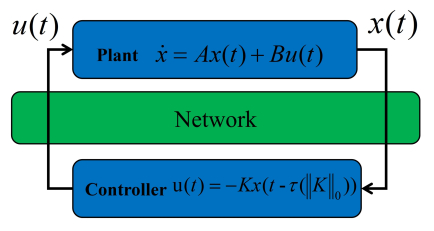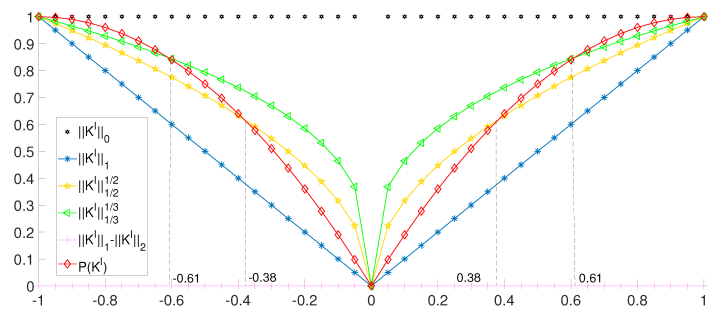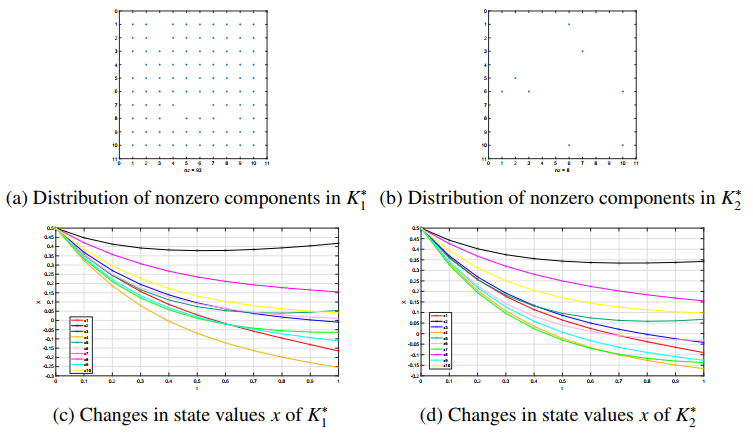1.
Introduction
Let ℵ be an algebra over complex field C. A mapping (linear) ℧:ℵ→ℵ is considered as a derivation (respectively Lie derivation) on ℵ if ℧(ϖ1ϖ2)=℧(ϖ1)ϖ2+ϖ1℧(ϖ2) (resp. ℧([ϖ1,ϖ2])=[℧(ϖ1),ϖ2]+[ϖ1,℧(ϖ2)]) holds for all ϖ1,ϖ2∈ℵ. Right away we explore a popular family of maps. Characterize the arrangement of polynomials:
For n≥2, the polynomial Pn(ζ1,ζ2,⋯,ζn) is known as (n-1)-th commutator. A Lie n-derivation on ℵ is defined as
for all ζ1,ζ2,⋯,ζn∈ℵ, where ℧ is a linear map ℧:ℵ→ℵ. Along these lines, Abdullaev [1] initiated and conceived the idea of Lie n-derivation on von Neumann algebras. Notice that any Lie 2-derivation is known as Lie derivation and Lie 3-derivation is said to be Lie triple derivation. Therefore Lie, Lie triple, Lie n-derivation are comprehensively recognized as Lie type derivations on ℵ.
In the recent past assessment of the conditions under which a linear map becomes a derivation (Lie derivation) fascinate the courtesy of many algebraists (see [2,3,4,5,6] and in their bibliographic content). Commonly, the object of the above studies was to attain the stipulations under which derivations (Lie derivations) can be absolutely determined by way of the action on some subsets of the algebras. On the analysis of local actions of Lie derivations on operator algebras, although there numerous research articles have been published. In 2010, Lu and Jing [2] initiated the study of local actions of Lie derivations of operator algebras and they characterized the action of Lie derivation on B(ζ). Exactly, they established that if ζ is Banach space of dimension greater then two and a linear map ℧:B(ζ)→B(ζ) such that ℧([ϖ1,ϖ2])=[℧(ϖ1),ϖ2]+[ϖ1,℧(ϖ2)] for all ϖ1,ϖ2∈B(ζ) with ϖ1ϖ2=0 (resp. ϖ1ϖ2=Y, where Y is a fixed nontrivial idempotent), then there exists an operator r∈B(ζ) and a linear map ϕ:B(ζ)→CI vanishes at all the commutators [ϖ1,ϖ2] with ϖ1ϖ2=0 (resp. ϖ1ϖ2=Y) such that ℧(ϖ1)=rϖ1−ϖ1r+ϕ(ϖ1) for all ϖ1∈B(ζ). Motivated by the work of Lu and Jing [2], Ji and Qi in [4] studied the conditions under which Lie derivations can be completely determined by their actions on the triangular algebras. Namely, they proved that under certain restrictions on triangular algebra T over commutative ring R, if ℧:T→T is an R-linear map such that ℧([ϖ1,ϖ2])=[℧(ϖ1),ϖ2]+[ϖ1,℧(ϖ2)] for all ϖ1,ϖ2∈T with ϖ1ϖ2=0 (resp. ϖ1ϖ2=p, where p is the standard idempotent of T), then there exists a derivation δ:T→T and an R-linear map ϕ:T→Z(T) vanishes at all the commutators [ϖ1,ϖ2] with ϖ1ϖ2=0 (resp. ϖ1ϖ2=p) such that ℧=δ+ϕ. In 2013, Ji et al. [3] characterized Lie derivations on factor von Neumann algebra with dimension greater than 4 and obtained the similar conclusion. Furthermore, Qi [5] characterized Lie derivation on J-subspace lattice algebras and proved the same result due to Lu and Jing [2] on J-subspace lattice algebra AlgL, where L is J-subspace lattice on a Banach space ζ over the real or complex field with dimension greater than 2.
Apart from these, Liu [6] investigated the Lie triple derivation on factor von Neumann algebra with dim>1 and stated that a linear map ℧:ℵ→ℵ satisfying ℧([[ϖ1,ϖ2],ϖ3])=[[℧(ϖ1),ϖ2],ϖ3]+[[ϖ1,℧(ϖ2)],ϖ3]+[[ϖ1,ϖ2],℧(ϖ3)] for all ϖ1,ϖ2,ϖ3∈ℵ with ϖ1ϖ2=0 (resp. ϖ1ϖ2=Y, where Y is a fixed nontrivial projection of ℵ). Then there exist an operator T∈ℵ and a linear map γ:ℵ→CI annihilates each 2-commutator γ([[ϖ1,ϖ2],ϖ3])=0 with ϖ1ϖ2=0 (resp. ϖ1ϖ2=Y) such that ℧(ζ)=ζT−Tζ+γ(ζ) for all ζ∈ℵ. Recently, many authors examined Lie n-derivation on various kind of algebras (see [7,8,9,10] and references therein). However, so far, there is no known study about of the local actions of Lie type derivations on operator algebras, it needs to be analyzed further. A linear map ℧:ℵ→ℵ is said to be Lie n-derivable at a given point Z∈ℵ if
for all ζ1,ζ2,⋯,ζn∈ℵ with ζ1ζ2=Z. The condition of being a Lie n-derivable map at some point can easily be seen to be much weaker than the condition of being a Lie n-derivation.
Spurred by using the above cited references, it is very natural to examine Lie type derivation on factor von Neumann algebra of dim>1. In this manuscript, we characterize Lie type derivation on factor von Neumann algebra which has standard form at zero product as well as at projection product.
2.
Preliminaries
Across the whole manuscript, let B(H) be an algebra of all bound linear operators on H, where H be a complex Hilbert space. Recognize that a von Neumann algebra ℵ acting on H is a self-adjoint, weakly closed algebra of operators containing an identity operator. A factor von Neumann algebra is a von Neumann algebra whose center contains only scalar operators. The factor-von-Neumann algebra (i.e., the center of ℵ is CI, where I is the identity of ℵ) is referred by ℵ⊆B(H). Let Q1 and Q2 be two projections in ℵ satisfying Q1+Q2=I and let ℵij=QiℵQj,1≤i,j≤2. Then ℵ=∑1≤i,j≤2ℵij. This signifies ζij∈ℵij,1≤i,j≤2 according to what accepts, whenever we start reading ζij. The factor von Neumann algebra ℵ is widely known to be prime (i.e., a lack of nontrivial tensor product decomposition for ℵ). Towards the concept of von Neumann algebras, we conclude with recommendations to [11]. We often use the following observation while proving the key result of this manuscript.
Lemma 2.1. Let ζii∈ℵii,i=1,2. If ζ11Y12=Y12ζ22 for all Y12∈ℵ12, then ζ11+ζ22∈CI.
Proof. As ℵ is prime, then for any ζ11∈ℵ11,Y12∈ℵ12, we find that ζ11Y11Y12=Y11Y12ζ22=Y11ζ11Y12. This leads to ζ11Y11=Y11ζ11. Clearly, ℵ11 is a factor von Neumann algebra on Q1H and hence ζ11=λ1Q1,λ1∈C. In the similar manner, ζ22=λ2Q2,λ2∈C. This implies that λ1=λ2 and then ζ11+ζ22∈CI.
3.
Characterization at zero product
During this segment, the characterization of Lie n-derivation on factor von Neumann algebras at zero product is considered as follows:
Theorem 3.1. Let ℵ be a factor von Neumann algebra with dim>1 acting on a Hilbert space and a linear map ℧:ℵ→ℵ satisfying
for all ζ1,ζ2,⋯,ζn∈ℵ with ζ1ζ2=0. Then there exist an operator T∈ℵ and a linear map γ:ℵ→CI that annihilates every (n-1)-th commutator Pn(ζ1,ζ2,⋯,ζn) with ζ1ζ2=0 such that ℧(ζ)=ζT−Tζ+γ(ζ) for all ζ∈ℵ.
Let Q0=Q1℧(Q1)Q2−Q2℧(Q1)Q1 and let us define a map δ:ℵ→ℵ as an inner derivation δ(ζ)=[ζ,Q0] for all x∈ℵ. Clearly ℧′=℧−δ is also a Lie n-derivation. Since
we get Q1℧′(Q1)Q2=Q2℧′(Q1)Q1=0. One need only consider these Lie n-derivation ℧:ℵ→ℵ that satisfy Q1℧(Q1)Q2=Q2℧(Q1)Q1=0.
Lemma 3.1. ℧(Q1),℧(Q2)∈CI.
Proof. Now ζ12Q1=0 for all ζ12∈ℵ12, then
Multiplying from the left side Q1 and from the right side of the aforementioned equation Q2, we find that Q1℧(Q1)ζ12=ζ12℧(Q1)Q2 and by Lemma 2.1, we have ℧(Q1)∈CI.
Now using Q2Q1=0, it follows that
This implies that Q1℧(Q2)Q2=Q2℧(Q2)Q1=0. Also, on using Pn(Q2,ζ12,Q1,⋯,Q1)=0 and applying the similar calculation as above, we get ℧(Q2)∈CI.
Lemma 3.2. ℧(ℵij)⊆ℵij,1≤i≠j≤2.
Proof. Now consider the case for i=1 and j=2. On using (3.1) and ℧(Q1)∈CI, we have
It follows that Q1℧(ζ12)Q1=Q2℧(ζ12)Q2=0. Also, if n is even, then 2Q2℧(ζ12)Q1=0. But when n is odd, then for any ζ12,Y12∈ℵ12, we calculate that
This leads to [℧(ζ12),Y12]+[ζ12,℧(Y12)]=λI∈CI. Then
This gives [Q2℧(ζ12)Q1,Y12]∈CI and hence Q2℧(ζ12)Q1Y12=0. Since ℵ is prime, we have Q2℧(ζ12)Q1=0. Therefore, ℧(ℵ12)⊆ℵ12. In the similar manner, we can show that ℧(ℵ21)⊆ℵ21.
Lemma 3.3. There exist linear functionals γi on ℵii such that ℧(ζii)−γi(ζii)I∈ℵii for any ζii∈ℵii,i=1,2.
Proof. Since ζ11Q2=0 and from Lemma 3.1, we have
Then Q1℧(ζ11)Q2=Q2℧(ζ11)Q1=0. Now for any ζ22∈ℵ22 and Y12∈ℵ12, we arrive at
This leads to [℧(ζ11),ζ22]+[ζ11,℧(ζ22)]=λI∈CI. By multiplying the above equation by Q2, on both ends, we conclude that [Q2℧(ζ11)Q2,ζ22]=λQ2 which leads to [Q2℧(ζ11)Q2,ζ22]=0. Then there exists ¯λ∈C such that Q2℧(ζ11)Q2=¯λQ2 and hence
A linear functional one can describe as γ1 on ℵ11 by γ1(ζ11)=¯λ∈C and combining with the above equation, we have ℧(ζ11)−γ1(ζ11)I=Q1℧(ζ11)Q1−¯λQ1∈ℵ11 for all ζ11∈ℵ11.
With the similar arguments, we can get a linear functional γ2 on ℵ22 such that γ2(ζ22)=¯λ∈C and ℧(ζ22)−γ2(ζ22)I∈ℵ22 for all ζ22∈ℵ22.
Now, we define a linear map χ:ℵ→ℵ by χ(ζ)=℧(ζ)−γ1(Q1ζQ1)I−γ2(Q2ζQ2)I for all ζ∈ℵ. It can be easily seen that χ(Qi)=0,χ(ℵij)⊆ℵij,i,j=1,2 and χ(ζij)=℧(ζij) for all ζij∈ℵij,1≤i≠j≤2.
Lemma 3.4. (1) χ(ζiiYij)=χ(ζii)Yij+ζiiχ(Yij) for any ζii∈ℵii,Yij∈ℵij,1≤i≠j≤2.
(2) χ(ζijYjj)=χ(ζij)Yjj+ζijχ(Yjj) for any ζij∈ℵij,Yjj∈ℵjj,1≤i≠j≤2.
Proof. (1) Since Yijζii=0,i≠j, it follows that
(2) Similar to (1).
Lemma 3.5. χ(ζiiYii)=χ(ζii)Yii+ζiiχ(Yii) for all ζii,Yii∈ℵii,i=1,2.
Proof. For any Yij∈ℵij, we have
It follows that χ(ζiiYii)Yij=ζiiχ(Yii)Yij+χ(ζiiYii)Yij. Since ℵ is prime, we find that χ(ζiiYii)=χ(ζii)Yii+ζiiχ(Yii) for all ζii,Yii∈ℵii,i=1,2.
Lemma 3.6. χ(ζijYji)=χ(ζij)Yji+ζijχ(Yji) for any ζij∈ℵij,Yji∈ℵji,1≤i≠j≤2.
Proof. For any ζ12∈ℵ12,ζ12Q1=0, then
As χ(ζ)=℧(ζ)−γ1(Q1ζQ1)I−γ2(Q2ζQ2)I for all ζ∈ℵ. This implies that
Multiplying the aforementioned equation to the left and right side by ζ12 respectively, we get some of that
Even before we comparing these two above expressions, we notice that
On application of Lemma 3.4, we get
From (3.4) it follows that ζ12γ1(ζ12Y21)−ζ12γ2(Y21ζ12)=0 and hence γ1(ζ12Y21)I−γ2(Y21ζ12)I=0. This imply to χ(ζ12Y21)=χ(ζ12)Y21+ζ12χ(Y21) and χ(Y21ζ12)=χ(Y21)ζ12+Y21χ(ζ12) for all ζ12∈ℵ12,Y21∈ℵ21.
Proof of Theorem 3.1. In view of Lemma 3.4-3.6, it can be easily seen that χ is an additive derivation. Now in order to complete the proof, we define a map γ(ζ)=℧(ζ)−χ(ζ) for all ζ∈ℵ. It is easy to observe that γ(ζii)∈CI, for i=1,2 and γ(ζij)=0 for i≠j. Clearly, γ is map from ℵ to CI. Also, by [11] we know that every derivation is an inner derivation, then there exists an operator T∈ℵ such that χ(ζ)=ζT−Tζ for all ζ∈ℵ.
Now we show that γ(Pn(ζ1,ζ2,…,ζn))=0 for all ζ1,ζ2,…,ζn∈ℵ.
We can draw the conclusion according to the above observations if ℧:ℵ→ℵ is a Lie n-derivation, then there exists an additive derivation χ of ℵ and a map γ:ℵ→CI vanishing at Pn(ζ1,ζ2,…,ζn) with ζ1ζ2=0 for all ζ1,ζ2,…,ζn∈ℵ such that ℧=χ+γ.
4.
Characterization at projection product
This segment is devoted to the analysis of a characterization by action of the nontrivial projection product of Lie n-derivations on factor von Neumann algebras and demonstrates the following observations:
Theorem 4.1. Let ℧:ℵ→ℵ be a linear map such that
where ℵ is a factor von Neumann algebra with dim>1 acting on a Hilbert space and for every ζ1,ζ2,⋯,ζn∈ℵ with ζ1ζ2=Q1, Q1∈ℵ a fixed nontrivial projection. Then there exist an operator T∈ℵ and a linear map γ:ℵ→CI that annihilates every (n−1)-th commutator Pn(ζ1,ζ2,⋯,ζn) with ζ1ζ2=Q1 such that ℧(ζ)=ζT−Tζ+γ(ζ) for every ζ∈ℵ.
Let Q0=Q1℧(Q1)Q2−Q2℧(Q1)Q1 and let us define δ:ℵ→ℵ as an inner derivation δ(ζ)=[ζ,Q0] for all ζ∈ℵ. Clearly ℧′=℧−δ is also a Lie n-derivation. Therefore we've got
to get Q1℧′(Q1)Q2=Q2℧′(Q1)Q1=0. It's indeed reasonable, therefore, to recognize only Lie n-derivation ℧:ℵ→ℵ satisfy Q1℧(Q1)Q2=Q2℧(Q1)Q1=0.
Lemma 4.1. ℧(Q1),℧(Q2)∈CI.
Proof. Now we know that (ζ12+Q1)Q1=Q1 for all ζ12∈ℵ12, then
We achieve Q1℧(Q1)ζ12=ζ12℧(Q1)Q2 upon multiplying the Eq (4.1) by Q1 from the left side and Q2 from the right side. Also, by Lemma 2.1, we get ℧(Q1)∈CI. Further, by using (Q2+Q1)Q1=Q1 we obtain
This implies that Q1℧(Q2)Q2=Q2℧(Q2)Q1=0. Also, using
and applying the similar calculation as above, we get ℧(Q2)∈CI.
Lemma 4.2. ℧(ℵij)⊆ℵij,1≤i≠j≤2.
Proof. Taking into account the situation for i=1 and j=2, applying (4.1) and ℧(Q1)∈CI, we have
It follows that Q1℧(ζ12)Q1=Q2℧(ζ12)Q2=0. Also, if n is even, then 2Q2℧(ζ12)Q1=0. But when n is odd, then for any ζ12∈ℵ12, we calculate that
Multiplying both sides by Q2, we obtain that Q2℧(ζ12)ζ12=0. Moreover, we have
Multiplying by ζ12 from right side and using the fact Q2℧(ζ12)ζ12=0, we obtain that ζ12℧(Y12)ζ12=0. On linearization we find ζ12℧(Y12)ς12+ς12℧(Y12)ζ12=0 for all ς12,ζ12∈ℵ. It is easy to observe that
Since ℵ is prime, we have Q2℧(Y12)ζ12℧(Y12)Q1=0, and hence Q2℧(Y12)Q1=0 for all Y12∈ℵ. Therefore, ℧(ℵ12)⊆ℵ12. In the similar manner, we can show that ℧(ℵ21)⊆ℵ21.
Lemma 4.3. There exist linear functionals γi on ℵii such that ℧(ζii)−γi(ζii)I∈ℵii for any ζii∈ℵii,i=1,2.
Proof. Consider for i=1. Suppose that ζ11 is invertible in ℵ11, then there exists ζ−111∈ℵ11 such that ζ11ζ−111=ζ−111ζ11=Q1. Now we have
It follows from (ζ−111+Q2)ζ11=Q1
For any Y22∈ℵ22 and Z12∈ℵ12, since (ζ−111+Y22)ζ11=Q1, it is easy to observe that
This leads to [Q1℧(Y22)Q1,ζ11]+[Y22,Q2℧(ζ11)Q2]=λI∈CI. We achieve the following upon multiplying the equation drive above by Q2 on both sides, [Y22,Q2℧(ζ11)Q2]=λQ2 and hence [Y22,Q2℧(ζ11)Q2]=0. Then there exists ¯λ∈C such that Q2℧(ζ11)Q2=¯λQ2.
Suppose if ζ11 is not invertible in ℵ11. Let r be a real constant satisfying r>‖ζ11‖. Then rQ1−ζ11 is invertible in ℵ11. Following the preceding case Q1℧(rQ1−ζ11)Q2+Q2℧(rQ1−ζ11)Q1=0 and Q2℧(rQ1−ζ11)Q2=˜λQ2. Since ℧(Q1)=¯μI, we also have Q1℧(ζ11)Q2+Q2℧(ζ11)Q1=0 and Q2℧(ζ11)Q2=¯λQ2, where ¯λ=rμ−˜λ. Without loss of generality, we denote Q2℧(ζ11)Q2=˜λQ2. Thus for any ζ11∈ℵ11, we have ℧(ζ11)=Q1℧(ζ11)Q1+Q2℧(ζ11)Q2=Q1℧(ζ11)Q1−˜λQ1+˜λI.
We define a linear functional γ1 on ℵ11 by γ1(ζ11)=˜λ. Then combining with the above equation, we get ℧(ζ11)−γ1(ζ11)I=Q1℧(ζ11)Q1−˜λQ1∈ℵ11 for any ζ11∈ℵ11.
For i=2, we consider (Q1+Y22)Q1=Q1 to get Q2℧(Y22)Q1+(−1)n-1Q1℧(Y22)Q2=0 and then follow the similar steps as for i=1. Hence ℧(Y22)−γ2(Y22)I=Q2℧(Y22)Q2−˜λQ2∈ℵ22 for any Y22∈ℵ22.
Now, we define a linear map χ:ℵ→ℵ by χ(ζ)=℧(ζ)−γ1(Q1ζQ1)I−γ2(Q2ζQ2)I for all ζ∈ℵ. This would easily observed that χ(Qi)=0,χ(ℵij)⊆ℵij,i,j=1,2, and χ(ζij)=℧(ζij) for any ζij∈ℵij,1≤i≠j≤2.
Lemma 4.4. (1) χ(ζiiYij)=χ(ζii)Yij+ζiiχ(Yij) for any ζii∈ℵii,Yij∈ℵij,1≤i≠j≤2.
(2) χ(ζijYjj)=χ(ζij)Yjj+ζijχ(Yjj) for any ζij∈ℵij,Yjj∈ℵjj,1≤i≠j≤2.
Proof. (1) Firstly, we discuss for i=1,j=2. If ζ11 is invertible in ℵ11, then for any Z12∈ℵ12, we have (ζ−111Z12+ζ−111)ζ11=Q1. It follows that
Replacing Y12 with ζ−111Z12, we have χ(ζ11Y12)=χ(ζ11)Y12+ζ11χ(Y12). Suppose if ζ11 is not invertible in ℵ11. Let r be a real constant satisfying r>‖ζ11‖. Then rQ1−ζ11 is invertible in ℵ11. Then χ((rQ1−ζ11)Y12)=(rQ1−ζ11)χ(Y12)+χ(rQ1−ζ11)Y12. Clearly, Q1 is invertible in ℵ11, so we get χ(ζ11Y12)=χ(ζ11)Y12+ζ11χ(Y12) from the above equation.
For i=2,j=1, consider (Q1+ζ22−ζ22Z21)(Q1+Z21)=Q1, we have
This implies that χ(ζ22Y21)=χ(ζ22)Y21+ζ22χ(Y21) for all ζ22∈ℵ22 and Y21∈ℵ21.
(2) For i=1,j=2. Considering (Q1+ζ12)(Q1−Y22+ζ12Y22)=Q1 and using the same approach as above, we obtain that χ(ζ12Y22)=χ(ζ12)Y22+ζ12χ(Y22) for all ζ12∈ℵ12 and Y22∈ℵ22.
For i=2,j=1. Considering ζ11(Z21ζ−111+ζ−111)=Q1, we can prove that χ(ζ21Y11)=χ(ζ21)Y11+ζ21χ(Y11) for all ζ21∈ℵ21 and Y11∈ℵ11.
Lemma 4.5. χ(ζiiYii)=χ(ζii)Yii+ζiiχ(Yii) for any ζii,Yii∈ℵii,i=1,2.
Proof. Same as proof of Lemma 3.5.
Lemma 4.6. χ(ζijYji)=χ(ζij)Yji+ζijχ(Yji) for any ζij∈ℵij,Yji∈ℵji,1≤i≠j≤2.
Proof. For any ζ12∈ℵ12,(ζ12+Q1)Q1=Q1, then
As χ(ζ)=℧(ζ)−γ1(Q1ζQ1)I−γ2(Q2ζQ2)I for all ζ∈ℵ. This implies that
Multiply the above mentioned equation by ζ12 from both side, we notice that
By analyzing the two expressions described above, we notice that
On application of Lemma 4.4, we get
From (4.4) it follows that
and hence γ1(ζ12Y21)I−γ2(Y21ζ12)I=0. This imply to
and
for all ζ12∈ℵ12,Y21∈ℵ21.
Proof of Theorem 4.1. It's just like the Theorem 3.1 claims.
Acknowledgments
We are very grateful to the referee for his/her appropriate and constructive suggestions which improved the quality of the paper. This work was supported by the Deanship of Scientific Research (DSR), King Abdulaziz University, Jeddah, under grant number (G: 270-662-1440). The authors, therefore, gratefully acknowledge with thanks DSR for technical and financial support.
Conflict of interest
No potential conflict of interest in this paper.
















 DownLoad:
DownLoad: